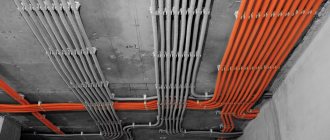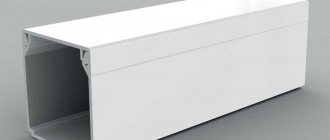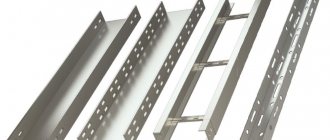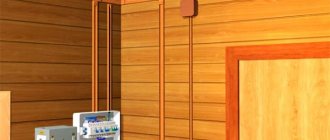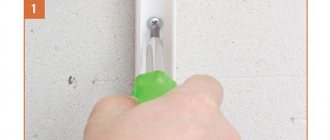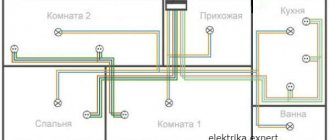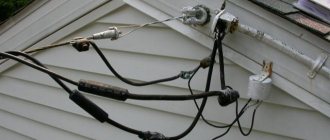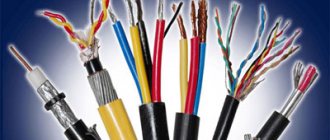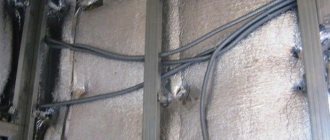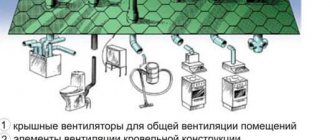The method of wiring a cable line on cables is a universal method of cable installation. In some cases, this is the only way to lay a power or lighting line, which depends on the complexity of the structural elements of a particular object.
| Price list for installation of couplings | |||
| № | Job title | Unit change | Price, rub.) |
| 1 | Installation of end couplings | PC. | 6000 |
| 2 | Installation of couplings | PC. | 15000 |
| 3 | Testing cables with couplings | PC. | 12000 |
| 4 | Dismantling couplings | PC. | 1500 |
| 5 | Cable puncture | PC. | 3000 |
Calculator | Full price list | Leave a request!
Cable laying is carried out using special cable wires that have protection. The main advantages of laying a cable line in this way are ease of execution, reliability, low cost of work and materials, and the ability to use this line in any external conditions. Cable laying on a cable has a wide range of applications, the most common examples of use may be:
- Power and distribution lines;
- Lighting;
- Trunk lines (up to 0.4 kW) in industrial premises.
The technique is suitable for laying long-distance external electrical wiring lines; the only difference is in the use of the materials of the supporting elements and the cable itself.
Structurally, cable cable laying is quite simple: the supporting cable is secured using tension anchors and (or) supporting devices, parts for fastening the cable to the supporting cable and a branch box, also equipped with fastening elements.
Application area
According to Chapter 2.1 of the PUE, this method is applicable for networks up to 1000 volts. Most often, cable wiring is used in places where organizing an overhead line does not make sense, and it is enough to throw a cable attached to the cable, and this will be enough to electrify the facility.
In this way, lighting networks and electrical wiring for sockets in warehouses, power cables in production workshops, and also between two separate buildings are installed.
For a home craftsman, this wiring method is of particular interest. This is because with the help of simple technology it is possible to electrify outbuildings in the country. Thanks to cable wiring, it is possible to conduct light from the house to a bathhouse, garage, shed, gazebo and other buildings and lighting devices located at some distance around the plot.
Preparatory work
First you need to decide on the wire and its cross-section. We talked about how to calculate cable cross-sections in the corresponding article. After this, you need to measure the length, taking into account the entire route of wiring from the machine to the distribution panel. When choosing a cable and suspension elements, you need to take into account the weight of the wire in a given area, with a threefold safety margin. Since in difficult weather conditions the load on the suspended structure increases, it can cause breakage and loss of power. Mostly galvanized steel cable with a diameter of 4.6 to 6.8 mm is used. In cases where the length of the suspension is short and the weight is such that it can be neglected, instead of cable wiring, string wiring can be used (galvanized steel wire or varnished hot-rolled wire from 5 to 10 mm is pulled).
Preliminary measures before installation
At the first stage, it is necessary to determine how much power will be consumed by electrical appliances in the structures that are planned to be provided with electricity. Based on the power consumption, the cross-section of the cable wires is calculated, its length and weight are taken into account. These parameters determine which fasteners to use, the diameter and material of the cable. To calculate power consumption and cable cross-section, a more detailed study of a separate topic is required. In simplified form it looks like this:
- The power of all electrical appliances that are supposed to be used in the calculated network is summed up. The power of each device is indicated in product passports or nameplates on the housing. The simplest example of a lighting lamp is always written 40 on them; 60; 75 or 100 or more watts.
∑Р = P1 + P2 +…Pn = 3.7 kW. (3700 W) – Total power.
- Determine the maximum possible current in the circuit
I = ∑Р/ U=3700 W/220 V = 16.8 A. – Maximum current.
U – network voltage.
- To determine the cross-section of wires in a cable, use the table
In our case, we choose a maximum current value slightly greater than 19A, taking into account that additional household appliances may be used in the future. According to the table, we obtain a power of 4.1 kW, which corresponds to a copper wire cross-section of 1.5 mm. You need to understand that the cross section is not the diameter, it is calculated using the formula:
Formula for calculating wire cross-section
Experienced electricians are well aware of the standards of cables and wires and determine the cross-section by eye. For ordinary consumers, there are tables for determining the cross-section by diameter ; it is enough to measure the diameter of the wire with a micrometer or caliper and determine its cross-section using the table.
Determining wire cross-section by diameter
- The next stage of preliminary work is measuring the length of the cable from the distribution board in the house to the switchgear (switchgear) on the building to which the cable structure is stretched. This can be done with a regular tape measure,
Tip #1. Be sure to take into account the cable reserve for cutting and connecting to the control panel; add approximately 30 cm at both ends.
Installation technology
First you need to secure the anchor and the fastening elements of the cable wiring to the selected area. For the most part, these are steel plates pulled together on both sides of the wall with studs and rings welded to them for hanging the cable. The tension of the fastenings is done to strengthen and avoid their falling out, distributing the weight of the load evenly along the wall, and not at the fastening points.
Next, you need to secure the cable on one side with special loop cable clamps, on the other side, tighten it as much as possible, and use screw couplings to get it to the state of the string.
The height of the suspension should not be lower than 2.75 meters above the pedestrian area, and not less than 6 meters above the vehicle passage. All standards for overhead electrical wiring, including the distance between supports, are indicated in the diagram:
After installing the strings, they begin tying the cable with a bandage. To hang cable wiring on the street, you can use plastic clamps, galvanized iron strips, and galvanized binding wire. The distance between the bandage is 50-80 cm.
Distribution boxes and lighting devices for cable mounting
To fasten distribution boxes, special galvanized iron plates with cut-out shapes are used. A part of the plate is bent from the cut-out shape, a cable and a box are inserted, after which everything is fixed with bent elements.
An example of attaching a junction box to a cable
To fasten lighting fixtures, galvanized plates of a special shape are used, but the principle of fastening remains the same, shown in the figure.
- Cable;
- Plate;
- Cable;
- Junction box;
- Lampshade with lamp socket.
Recommendation from practice
When using a binding wire, it is necessary to prevent the core from cutting into the insulation; for this purpose, a gasket is made between the bandage and the wire made of insulating material. The winding area of the bandage should be distributed as much as possible by laying 7-10 turns of the bandage. When using plastic clamps, check their operational data. Otherwise, in frosty winters or very hot summers, you will find scattered clamps.
When laying the cable externally along the cable, it is also necessary to protect the line from the influence of the environment on the insulation, so it is recommended to stretch it in a corrugation, as shown in the photo below. This will then reduce the cost of operation and restoration of cable wiring.
If the span is short or there is no possibility of attaching the cable to the cable at the installation site, it is possible to assemble the suspension on the ground. The already prepared structure can be stretched and attached.
By following our instructions, you can independently conduct electrical wiring to separate buildings in the country. We also recommend watching a useful video that shows how to make a loop on a cable with your own hands:
That's all I wanted to tell you about how to install cable wiring with your own hands. As you can see, laying a cable along a cable is a rather labor-intensive task, but it is still within the power of a home handyman!
It will be interesting to read:
Conducting an electrical part in the ground is a costly and troublesome undertaking. Trenches are first dug at the site and special cables are purchased. The high cost and labor intensity forces us to look for simpler solutions. Air fastening is simpler and cheaper, especially string fastening, when fastening the cable to the cable. It allows you to reduce costs on materials, equipment, and labor. A significant limitation in the use of technology can only be the length and large plants between objects. When buildings are located nearby, the best solution is to install cable wiring. It is simply irreplaceable in warehouses, workshops and other production facilities. The main thing is to secure the elements correctly and securely. Otherwise, this is fraught with cable breakage and corresponding negative consequences.
Laying cables in the air on cables
It is recommended to install cables on cables in cases where other types of cable laying cannot be used for technological, design or economic reasons. Laying power cables on cables is used in networks with voltages up to 1 kV, both indoors and outdoors. Cable wiring on cables indoors (workshops) is carried out along columns along and across the building, as well as between walls, and outdoors - as a rule, between the walls of buildings.
For power lines laid on a cable, the same cables are used as for laying inside buildings and structures. The choice of cable brand is determined by the project. Cables laid outside buildings, including under open sheds, must have a protective non-flammable outer covering.
The choice of cable is made depending on the load-bearing load. As a supporting cable, ropes woven from galvanized steel wires are used in accordance with GOST 3062-80 or GOST 3063-80, hot-rolled round steel in accordance with GOST 2590-71.
Laying the cable on cables: a - along columns, b - the same with fastening the cable to the wall, c - between walls 1 - final girth; 2 — tension coupling; 3 — cable suspension; 4 — supporting cable: 5 — intermediate girth; 6 - cable; 7 - column; B - anchor; 9 - wall; 10 — cable clamp.
The distance between the anchor fastenings of the supporting cable is determined in the project and should be no more than 100 m. The distance between intermediate fastenings should be no more than 30 m when laying one or two cables with a cross-section of up to 70 mm2, 12 m when laying more than two cables with a cross-section of 70 mm2 and in all cases of laying cables with a cross-section of 95 mm2 and above. The distance between cable hangers should be 0.8... 1 m. Anchor end structures should be attached to the walls or columns of buildings; fastening them to beams and trusses is not allowed.
Procurement of supporting ropes and cables, assembly of factory products and production of structures according to drawings should be carried out at assembly and procurement areas. Prepared sections of ropes and cables must be marked and wound on inventory drums.
Anchor devices must be attached to the walls of buildings using studs and bolts or a rotating folding strip, which is laid through a prepared hole in the wall. End and intermediate girths are secured to building columns with tie rods.
The lifting and securing of the supporting cable, rolled out along the route, is carried out from aerial platforms, hydraulic lifts, scaffolding, scaffolding, etc.
Installation of a tension coupling or a hand winch attached to the end of a supporting cable on an anchor, when the second end of the cable is fixed to another anchor, should be done by tensioning the cable with mounting blocks (pulley hoist). To do this, the cable must first be pulled out manually and secured in the block.
Installation of anchors on the wall and clamps on the column: a, b - on the wall with bolt fastening; c - on the wall with a folding bar; d, e - on a column on studs 1 - anchor; 2 — cable clamp; 3 - support cable; 4 - bolt; 5 — tension coupling; 6 — anchor with a folding bar; 7 — end girth, 8 — pin; 9 - column; 10 — intermediate girth.
The final tension of the supporting cable and adjustment of the sag are carried out using tension couplings or hand winches. The sag of the cable after laying the cables should be equal to 1/40... 1/60 of the span length, which for a span of 6 m is 100... 150 mm, and for a span of 12 m - 200... 300 mm.
It is recommended to roll out, lift and lay cables into suspended cable structures using special mechanisms and devices. Installation of one cable can be carried out together with installation of the supporting cable. For this purpose, the cable to the cable is fixed directly to the ground, with the help of mounting blocks or a winch they are lifted together with the cable and tensioned on the supporting cable, and then the cable is secured in anchor devices.
Special hand winch
Installation of a tension coupling on the anchor: 1 - supporting cable; 2 — mounting clamp; 3 — chain hoist; 4 - anchor; 5 — coupling connecting strip; 6 — tension coupling; 7 — cable clamp.
All metal products that are not painted or galvanized and bare areas of the steel cable indoors, as well as the entire length of the steel cable when laid outdoors, regardless of the presence of coating, must be coated with a lubricant (for example, grease). Indoors, a galvanized steel cable is coated with lubricant only in cases where it may be subject to destruction under the influence of an aggressive environment during operation.
Protection of cables laid openly in the air from sunlight must be carried out in accordance with the instructions given in the project.
An electrical cable line is a steel support cable from which insulated unprotected or protected cables are suspended. Methods for attaching wiring to a cable are universal: using special cable hangers, fastening directly to the cable (string hanger) and on suspended and supporting structures with insulators, as well as on slats, boxes, trays, pipes and other structures suspended from the cable.
In addition to the supporting cable and cables, the cable wiring line includes anchoring, tensioning and supporting devices, parts for attaching the cable to the supporting cable. To complete cable lines on cables, the following factory products and parts are used, necessary both for the preparation of lines and for their installation: tension couplings for steel cables with a screw stroke of 50, 100 and 300 mm; anchors for end fastening of steel cables to building elements; clamps for connecting hangers, guy wires and guy ropes with a supporting cable (including clamps fastening loops at the end of a steel cable), earrings for fastening cables to steel trusses.
A steel cable is used as a carrier, the diameter of which is selected according to the table.
Cable tension anchors, which serve for the end fastening of the supporting cable, adjusting its tension and sag, are attached to the building elements using bolts, folding strips, etc.
Supporting devices are intermediate string suspensions and longitudinal and transverse guys attached to the lower chords of trusses, columns, and ceilings. Intermediate fastenings are installed for large spans and the mass of the installed wiring every 18...24 m, reducing the sag and giving the line significant stability and mechanical strength.
Intermediate cable fastenings can additionally be made directly to beams, trusses, columns and floors using separate parts or wrapping structures.
Cable tension anchor: 1 - tension coupling; 2 — thimble; 3 — cable bolt clamp; 4 - cable.
To hold the cable in intermediate sections, three-bolt clamps are used, with the help of which the ends of the hangers and braces are terminated with loops using sleeves and clips. In some cases, for example, when there is a large distance from the cable suspension line to the floor trusses, a second unloading cable is used, which is pulled above the load-bearing cable, and to which intermediate fastening strings are attached.
The main scope of installation of cable electrical wiring is carried out in the MEZ. For delivery to the site, the end and intermediate fastenings are assembled into containers, and the prepared complete cable lines are rolled into coils with a diameter of 1...2 m or wound on special inventory cassettes or drums.
The main scope of installation of cable electrical wiring is carried out in the MEZ. For delivery to the site, the end and intermediate fastenings are assembled into containers, and the prepared complete cable lines are rolled into coils with a diameter of 1...2 m or wound on special inventory cassettes or drums.
Installation of anchor and tension structures, vertical suspensions, transverse and longitudinal braces, laying routes for supply lines is classified as the first stage of installation and is carried out with a certain readiness of the building elements to which the cable wiring is suspended and attached. The distances between the intermediate hangers, as well as the diameter of the cable, hangers and guy wires depend on the load on them and are determined by the design.
Metal parts of all elements of cable wiring without painting or galvanic coating, as well as exposed sections of the cable and anchor devices at the points of contact, must be lubricated with technical petroleum jelly. Metal brackets and flat strips for fastening cables should have a protective coating against corrosion and soft glassine pads.
Prepared cable lines: a - on inventory cassettes; b - in bays.
It is recommended to lift long (more than 15 m) and heavy cable cables to the design site using simple lifting devices (blocks, winches, etc.). In this case, one end of the support cable with a loop is put on an anchor hook fixed in the wall. The second end of the supporting cable is connected to the pulley with a wedge clamp or cam grip, located at some distance from the end loop, and the pulley is suspended on another anchor hook installed on the opposite wall of the room. In this case, the end of the cable with the tension coupling mounted on it is in a freely suspended state.
The cable cable suspended between the anchors is pulled with a pulley or winch.
After tension is completed, the free suspended end of the supporting cable with the tension coupling is put on the anchor hook, the pulley is loosened, disconnected from the cable and removed from the hook.
Intermediate cable fastenings are made on steel rope strings.
The final adjustment of the suspension of cable cables is carried out using a tension sleeve.
The supporting cables are grounded at two points at the ends of the line. On lines with a neutral wire, the supporting cable is connected to it with a flexible copper jumper with a cross-section of 2.5 mm2, and on lines with an insulated neutral - to a bus connected to the ground loop. It is not allowed to use a support cable as a grounding (neutral) conductor.
It is allowed to ground the support cable by welding the free end of a loop or a flexible steel jumper PGS-35 600 mm long to the grounding network of the room.
With a small amount of work, cable cable wiring can be prepared directly at the site where it is to be installed.
The preparation of cable wiring assemblies is carried out according to measurements taken at the installation site, or working drawings without preliminary measurements on site. In the first case, the electrician-measurer draws up sketches of cable cable lines, on which he records the exact dimensions between the end fastenings to walls or columns, and intermediate hangers. In the second case, a sketch order is drawn up based on the working drawing. The length of the cable is determined by the dimensions of the room indicated in the drawing. The standard sketch also indicates the type of anchorage, cable brands and their required lengths for installation.
Harvesting, processing of cables and their fastening to the cable are carried out on production lines. Unprotected cables are secured to the cable with plastic clips designed for intermediate fastening of a cable weighing up to 5 kg. The distance between the clips is usually 1.5 m. Direct fastening of the cable to the cable (in dry and wet rooms) with polyvinyl chloride perforated tape with buttons or buckles every 0.5 m is allowed.
Protected cables are attached to the cable with clasps, steel strips with buckles and plastic strips with buttons.
In table Cables with impregnated paper insulation recommended for installation in the air are shown.
Fastening wires and cables to the cable: a - with clips; b, c - steel strips with buckles, d - plastic strips with buttons.
Recommendations for the primary use of cables with impregnated paper insulation when laying in the air*
* Cases of laying in the air in general premises.
** Used in the presence of a chemically active environment.
Preparatory work for cable installation
To carry out the work efficiently, it is necessary to correctly calculate the cable cross-section. This parameter is directly dependent on the total power of the connected electrical appliances. The next step is to measure the distance between the machine and the switchboard. Be sure to take into account all climbs and turns. When all the necessary calculations have been carried out, a cable is selected. It must withstand the load exerted by the cable being laid along the entire length of the route. To eliminate the possibility of breakage during external installation, the strength of the cable and hanging elements is calculated based on three times the weight of the cable. Most often, galvanized cable with a diameter of 4.5 to 6.7 millimeters is used. The string method involves the use of galvanized steel wire or hot-rolled varnished wire with a thickness of 0.5 cm.
How to properly secure the cable?
The base must be strong and reliable, well secured. The cable and cable are installed using anchor fasteners. They are fixed on both sides of the wall or other base using bolts or studs. This allows you to evenly distribute the load and eliminate the possibility of fasteners falling out of the wall. The distance between anchors that are located in close proximity to each other should be less than 100 meters. To ensure greater reliability of fastening, additional anchors are installed every 30-40 centimeters. Between the cable suspensions the step is from 70 to 90 centimeters. The design provides a special loop clamp and a screw coupling, a manual winch or a pulley. They are located on opposite sides. The presence of these elements allows you to lift and tension the cable, as well as change its strength and stability. He is grounded. Under no circumstances should it be used as grounding. The degree of tension should not be maximum. The cable should not sag. You also shouldn’t be too zealous when pulling the cable. Overvoltage that occurs when exposed to low temperatures can cause it to burst.
Installation and tension of the cable
After installing the terminal fastenings, the cable is attached to the guy wire on the ground, lighting fixtures with junction boxes are fixed and connected. The assembled structure is delivered to the installation site and unwound along its entire length from one mounting anchor to another.
The length of the cable must be at least 2 m greater than the distance between the end anchors. The reserve will be needed to seal the fastening to the terminal devices and bring the ends to the grounding terminals, which are located below the anchors. The end loops of the cable are attached to the tension anchors, after which they regulate the tension. The tensile force should be up to 100 kg/cm for light structures with cables with a cross-section of 4-10 sq./mm. For heavy cables with a cross-section of 16 – 25 sq./mm – up to 500 kg./cm. This parameter is measured by a dynamometer, which is installed between the anchor and the tension loop.
After tensioning the cable, the ends of the cable are grounded, the cable is inserted into distribution devices and connected to protective circuit breakers.
Features of fastening methods
The use of a design in the form of a tray, box or pipe allows for additional protection of the wires from the harmful effects of the environment. This fastening method is advisable to use where the cable is directly affected by both low and high temperatures. Metal fasteners are less versatile and require additional precautions. They should not violate the insulation of the cable being laid. In other words, it is necessary to use additional elements placed under steel and iron buckles, for example, insulating material.
The cable is fastened directly to the cable using various fasteners - galvanized iron sheets, steel strips, plastic clamps. The first two fastening options are considered preferable. Plastic elements are selected taking into account operating conditions so that they do not require replacement every season.
Is it possible to replace a cable with a rope?
Often, some people decide to use a rope rather than a cable. Such a replacement cannot be made, since it does not have the required properties. Fabric fibers are easily destroyed under the influence of external negative factors. The rope easily stretches, frays and even breaks. Loss of strength can lead to sagging. If the wire breaks, it will create a dangerous situation where the electrical current could kill someone nearby.
FEDERAL UNIT PRICE FOR FARMS 08-02-149-01
| Name | Unit |
| Cable up to 35 kV, suspended on a cable, weight of 1 m of cable: up to 1 kg | 100 m cable |
| Scope of work | |
| 01. Installation and removal of the winch. 02. Installing and removing the drum. 03. Installation and removal of rollers. 04. Installation and dismantling of intercom. 05. Laying cable and cable. 06. Checking the condition of cable insulation before and after installation. 07. Marking. |
The price does not contain overhead costs and estimated profits; accordingly, the direct costs of work for the period 2000
(prices of the Moscow region), which are calculated based on
2009
. For further calculations, this cost must be multiplied by the conversion index to current prices.
You can go to the pricing page, which is calculated based on the 2014 edition standards with additions 1
| Total (RUB) | Workers' compensation | Machine operation | Pay for drivers | Cost of materials | Labor costs (person-hours) |
| 3975,25 | 164,5 | 2360,25 | 216,68 | 1450,5 | 17,1 |
TOTAL PRICE: RUB 3,975.25.
Look at the cost of this standard at current prices open page
Look at the resource part of the price in the GESNm standard 08-02-149-01
When used in an estimate, the price requires indexation to translate into current prices. The price is based on the GESN-2001 standards, as amended in 2009.
in
2000
.
